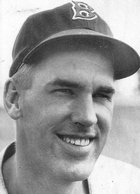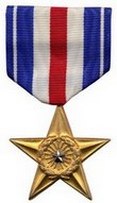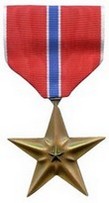Earl Johnson
Ballplayers Decorated in Combat
| Date and Place of Birth: | April 2, 1919 Redmond, WA |
| Date and Place of Death: | December 3, 1994 Seattle, WA |
| Baseball Experience: | Major League |
| Position: | Pitcher |
| Rank: | First Lieutenant |
| Military Unit: | Company B, 120th Infantry Regiment, 30th Infantry Division US Army |
| Area Served: | European Theater of Operations |
Earl D. “Lefty” Johnson was born in Redmond, Washington on April 2,
1919. He was an outstanding high school athlete and in July 1937, aged
18, he led the Johnson Paint Company team of Tacoma, to the Washington
state semi-pro championship. He was a National Baseball Congress
all-America selection, and earned an athletic scholarship to St. Mary’s
College.
At St. Mary’s, Johnson and teammate, Cy Greenlaw, dominated the
opposition but were still overshadowed by the outstanding collegiate
pitcher of the day, Emmett O'Neill. Nevertheless, Johnson had decided
that baseball was going to be his profession and he decided to pass up
the rest of his education in the fall of 1939. With the help of his
coach, Earl Sheely, he attracted the interest of the Boston Red Sox, and
was sent to their training camp at Sarasota, Florida, in the spring of
1940.
The Red Sox sent him to the Rocky Mount Red Sox of the Class B Piedmont
League, where he played under Heinie Manush. "I was supposed to go to
Canton, Ohio, in a smaller league," Johnson explained. "But during
spring training, Heinie Manush, who was managing Rocky Mount, talked Joe
Cronin into making the switch."
After winning 12 games and posting a 2.67 ERA in 19 games at Rocky
Mount, Johnson was called up by the Red Sox and made his first major
league appearance on July 20, 1940. He made a total of 17 appearances
for Boston with a 6-2 won-loss record.
Suffering from arm trouble, Johnson again made 17 appearances for Boston
in 1941 with an ERA of 4.52. In January 1942, he entered military
service and sent a telegram to Red Sox general manager, Eddie Collins,
which read: “Inducted into Army today. Best Regards.”
Johnson served with the 120th Infantry Regiment of the 30th Infantry
Division. The 30th Infantry Division arrived in England in February
1944, and trained in preparation for D-Day. The division landed at Omaha
Beach, Normandy, on June 11, 1944, and spearheaded the St. Lo
breakthrough. “We were a replacement unit,” he explained. “We had to go
through Omaha Beach to get there [St. Lo]. The wreckage was still there,
the burned-out tanks and half-sunken ships and assault boats that were
just so much twisted steel.”
On September 30, 1944, Johnson, a rifle platoon sergeant earned his
first combat honor – a bronze star. His citation read: “During heavy
concentration of hostile fire, a friendly truck was struck by an enemy
shell and had to be abandoned. The fact that the vehicle contained vital
radio equipment made it imperative that it be recovered before falling
into enemy hands. Sergeant Earl Johnson and several others members of
his unit were assigned to this hazardous mission. They courageously
braved a severe hostile fire and were completely successful in dragging
the vehicle over an area in plain view of the enemy.”
In addition to the Bronze Star, Johnson also received a battlefield
commission promoting him to second lieutenant.
Months later, Johnson was awarded a Silver Star for bravery during the
Battle of the Bulge, and further promotion to first lieutenant.
In 1945, Red Sox general manager Eddie Collins received a letter from
Johnson dated February 10. "I have been in combat for six months,"
Johnson wrote. "It sure has been a long road. It really has been tough.
It seems like I have been fighting for years. I sure will be glad when
it is over."
In October 1945, Johnson returned to the United States. He immediately
returned to his home in Seattle, to spend his furlough, and had the
opportunity to work out briefly with the Seattle Pacific Coast league
team. Johnson then went to Camp Jackson, South Carolina, to await his
discharge which came in December.
Reminiscing about his Army life, Johnson told of the time he and his
platoon were trying to knock out some German tanks. Earl threw a couple
of hand grenades and missed. A member of his platoon - a kid who had
never thrown a baseball in his life - threw two grenades and scored two
direct hits. "If only I had that kid's control," he concluded, "what a
pitcher I would be."
Johnson returned to the Red Sox in 1946, and hurled three hitless
innings against the Cardinals in spring training. "After four years in
the Army, in which I didn't throw a ball," he declared, "I have just
begun to feel at home on the mound." Johnson pitched in 29 games for the
Red Sox in 1946, mainly as a reliever. He had a 5-4 won-loss record and
a 3.71 ERA. He had his best major league season in 1947, appearing in 45
games, with a career-high 12 wins and a career-best 2.97 ERA.
Johnson remained with the Red Sox until he was released following the
1950 season. He signed with the Tigers but only made six brief
appearances before being released in June.
Johnson remained in baseball as a scout for the Red Sox. In all, he was
associated with the team for 44 years. He passed away on December 3,
1994, in Seattle, Washington, aged 75.
Date Added January 21, 2018
Can you add more information to this biography and help make it the best online resource for this player? Contact us by email
Read Baseball's Greatest Sacrifice Through The Years - an online year-by-year account of military related deaths of ballplayers
Baseball's Greatest Sacrifice is associated with Baseball Almanac
Baseball's Greatest Sacrifice is proud to be sponsored by



